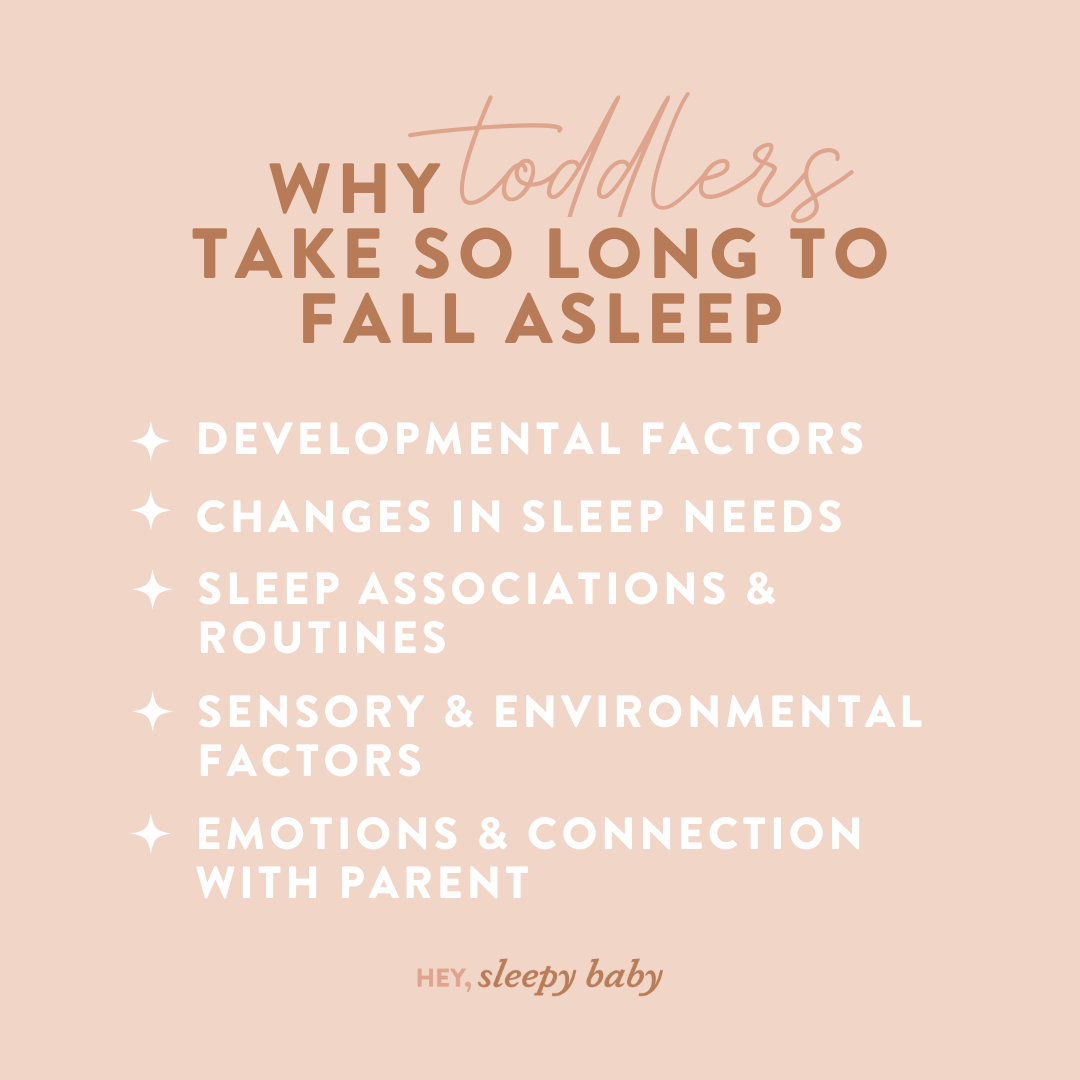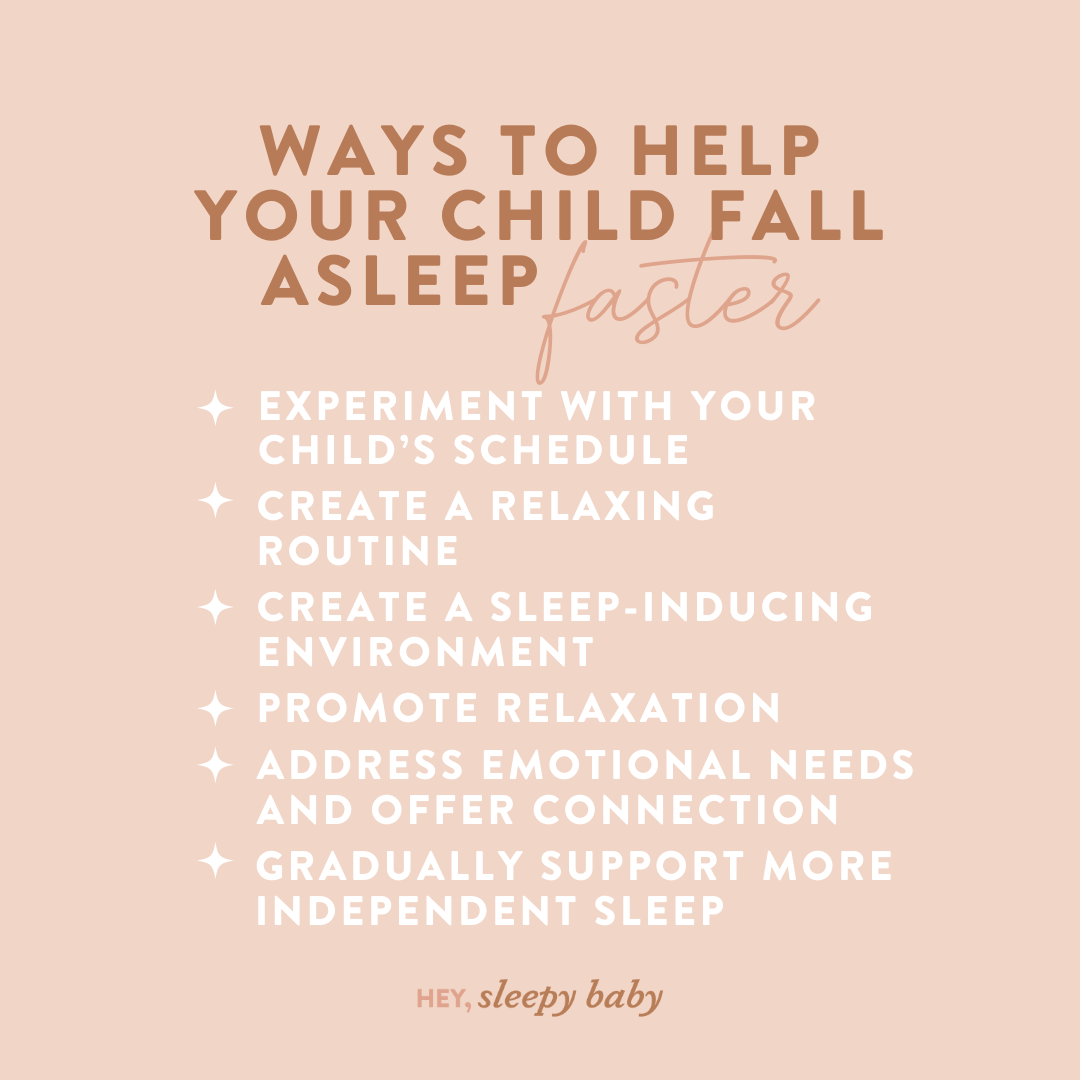I'm Rachael
Mom of 3 & Baby Sleep Expert with Big Sis Energy
& I’VE DONE ALL THE RESEARCH FOR YOU ALREADY.
Better sleep for the entire family
BROWSE COURSES
hey!
toddler taking forever to fall asleep at bedtime? here’s why it might take your child a long time to fall asleep and what you can do about it.
June 25, 2023
in this post:
Bedtime can be a challenging time for both children and parents, especially when toddlers and young children have difficulty falling asleep. Many factors contribute to this common bedtime struggle, leaving parents wondering how to create a peaceful and restful sleep routine without resorting to sleep training methods. In this blog post, we delve into why it might take a toddler or young child a long time to fall asleep at bedtime and explore various strategies parents can try to help their little ones settle into a peaceful slumber without sleep training.

why is it taking so long to fall asleep?
Developmental factors
Toddlers and young children undergo significant developmental changes that can affect their sleep patterns. Rapid cognitive, physical, and emotional growth can create an overstimulated mind and busy body at bedtime. At this stage, children’s imaginations flourish, leading to a higher likelihood of bedtime fears, separation anxiety, and a vivid imagination, making falling asleep difficult, scary, etc.
Change in sleep needs
As children grow, they tend to need less sleep. If your child is still taking a very long nap during the day, they may not have enough sleep pressure if they have the same bedtime they’ve had since infancy. Toddlers ages 1-2 need just 11-14 total hours sleep (on average) per 24 hours split between nap(s) and nighttime, compared with 12-16 hours they needed during their infancy. As they grow into preschoolers, they need even less sleep- around 10-13 hours for 3-5 year olds.

Sleep associations & routines
Children, like all of us, rely on certain sleep associations to feel secure and comfortable enough to fall asleep. These associations can vary from nursing or rocking to a specific stuffed animal or blanket to needing a parent’s presence. Establishing consistent bedtime routines helps create a calming environment and signals to the child that sleep is approaching. However, if the child becomes reliant on specific sleep associations, they may struggle to fall asleep independently. This is only a problem if it’s a problem for you! It’s completely acceptable to lay with your child while they fall asleep. You may not mind this, but you want it to take less than 30-60 minutes. That’s where this blog post comes in- so keep reading!
Sensory & environmental factors
The sensory environment plays a crucial role in a child’s ability to transition to sleep. Excessive noise, bright lights, or stimulating activities close to bedtime can hinder relaxation and lead to prolonged sleep onset. Creating a soothing and dimly lit bedroom, limiting stimulating activities before bed, and incorporating relaxing activities can set the stage for better sleep initiation. Some children have more reactive or sensitive sensory systems and more sensitive temperaments. These children may require even more time to wind down in the evening. However, they also may require lots of rich sensory input throughout the day. This can be a tricky balance.
Emotions & connection with parent
A child’s emotional state greatly impacts their ability to fall asleep. Stress, anxiety, and emotional upheavals can make it challenging for toddlers to unwind at bedtime. Establishing a secure and loving connection with parents during the day, ensuring adequate emotional support, and engaging in calming activities together can help children regulate their emotions and promote better sleep onset. This is often a tricky one for us parents because we so badly want to clock out at bedtime. When our child clings to us and needs so much at bedtime it can be incredibly triggering. I talk much more about how to cope with this and how to turn things around so that your child doesn’t need to desperately seek you out at night in the Better Bedtimes Guide.

strategies for helping your child fall asleep faster
Understanding the reasons behind a toddler or young child’s prolonged bedtime struggles can empower parents to support their little ones effectively. By implementing strategies that focus on creating a peaceful sleep environment, establishing consistent routines, and addressing emotional needs, parents can promote healthy sleep habits without resorting to sleep training methods. Remember, every child is unique, and it may take time to find the approach that works best for your child. Be patient, provide a nurturing environment, and remember that bedtime can be an opportunity for bonding and connection with your little one. Here are a few things to try:
Experiment with your child’s schedule
If they are still taking a long midday nap and/or have an early bedtime, see if a little less daytime sleep helps them settle more easily for bedtime. You can cap their nap by 15-20 minutes at a time, push bedtime later by 15-30 minutes, or both until you find a sweet spot.
create a relaxing routine
Create a relaxing routine with calming activities such as reading a book, taking a warm bath, doing gentle stretching or deep breathing exercises. Set a fixed bedtime and wake-up time to regulate the child’s internal clock.
Create a sleep-inducing environment:
Ensure the bedroom is comfortable, quiet, and dark, with a temperature conducive to sleep. Consider using white noise or soothing music to drown out external noises. Offer a cozy environment with things like soft blankets and stuffed animals.

address emotional needs & offer connection
Provide emotional support and validation during the day to alleviate anxiety or stress. Allow time for a calm and connected bedtime routine, fostering a sense of security.
Gradually support more independent sleep
Remember that there is nothing wrong with your child wanting you close at nighttime. Laying with your child is a lovely way to end the day. However, you may want to gradually reduce parent-dependent sleep associations if this is something your’e resenting or that is not sustainable for you. There are many ways to add you presence without having to physically lay with your child for hours, such as giving them a special photo or object, a piece of your clothing, etc.
Offer reassurance and check-ins while gradually increasing the time between visits. There are lots of ways you can do this in a gentle way that won’t cause your child to panic or feel abandoned. Check out the Better Bedtimes Guide for evidence-based and real life strategies that you can start to implement tonight!
Some toddlers who are still nighttime nursing may sleep better after weaning. The Night Weaning Workshop shows you how to gently wean your toddler from nursing or bottles gradually, including feeding to sleep at bedtime. If you are looking to move on from cosleeping or to make other supported changes to sleep, then check out our Tender Transitions Course.
Featured
Most parents get to a point where their current method of supporting baby’s sleep stops working. Perhaps you want to switch things up in your bedtime routine, or you want to change what you use to help your baby to sleep. Whatever your reason for wanting to change up the sleep associations, these are my quick tips for making gentle changes without any need for sleep training.
Bedtime can be a challenging time for both children and parents, especially when toddlers and young children have difficulty falling asleep. Many factors contribute to this common bedtime struggle, leaving parents wondering how to create a peaceful and restful sleep routine without resorting to sleep training methods. In this blog post, we will delve into why it might take a toddler or young child a long time to fall asleep at bedtime and explore various strategies parents can try to help their little ones settle into a peaceful slumber without sleep training.
Most children will hang onto their nap until between 2.5-4 years old, though for some who are lower sleep needs it might be even younger. High sleep needs nap lovers may continue napping well over 5 if given the chance!
Was this helpful? Save it for later!

binge reads
We think you'll love these
You deserve to the
baby stage, not just "survive it."
And you DON'T have to sacrifice your values, ignore your instincts, or force yourself to follow a method you don't align with just to get your baby back to sleep.
I’m here to help you create a restful, sustainable sleep environment that honors both your baby’s needs AND your own (without the stress OR the guilt!) because, no, you don’t have to choose between the two.
enjoy!
BABY SLEEP COURSES →
BABY SLEEP CONSULTS →
Wish you could help your baby sleep better without resorting to sleep training? Download my FREE guide to a good night’s sleep and learn 8 simple, science-backed tips for supporting your child’s needs.
Traditional sleep training methods don’t have to be your solution to better sleep.
SLEEP TRAINING ISN’T THE ONLY WAY TO GET GOOD SLEEP
Hey, I'm Rachael and Hey, Sleepy Baby is for parents who want to get their nights back, without sleep training their babies.
NO ONE TOLD US POD
explorING the untold truths of parenting





